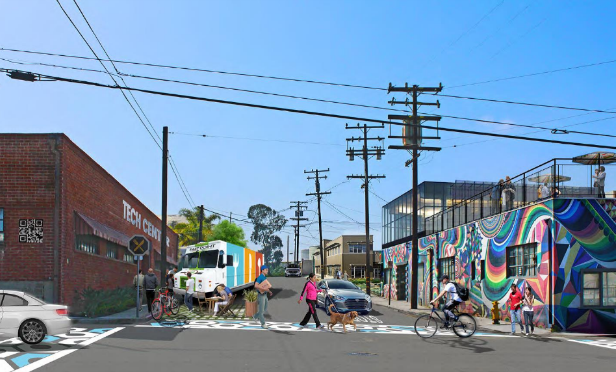 El Segundo has revealed plans to overhaul the Smoky Hollow district, a 120-acre site between Pacific Coast Highway and historic Downtown El Segundo. The area has recently emerged as a creative hub. The new Smoky Hollow Specific plan will encourage more growth by allowing for adaptive reuse projects—a strategy that spurred major growth in Downtown Los Angeles. This will allow developers to convert industrial space into office space, increasing the existing office supply in the city by nearly 900,000 square feet by 2040. We sat down with Gregg McClain, El Segundo planning manager, to hear more about the new plan and how it will impact the city.
El Segundo has revealed plans to overhaul the Smoky Hollow district, a 120-acre site between Pacific Coast Highway and historic Downtown El Segundo. The area has recently emerged as a creative hub. The new Smoky Hollow Specific plan will encourage more growth by allowing for adaptive reuse projects—a strategy that spurred major growth in Downtown Los Angeles. This will allow developers to convert industrial space into office space, increasing the existing office supply in the city by nearly 900,000 square feet by 2040. We sat down with Gregg McClain, El Segundo planning manager, to hear more about the new plan and how it will impact the city.
GlobeSt.com: What is the vision for the redevelopment of Smoky Hollow?
Gregg McClain: Smoky Hollow is slowly transitioning to a district characterized by creative offices, small studios and similar uses. Our present specific plan envisioned that the district would remain light industrial with a sprinkling of these other uses. In the past decade or so the light industrial uses are continuing to be replaced by design studios, creative and professional offices and the like. So with this update to the specific plan, we are trying to align our vision with what is happening organically. We want to capitalize on Smoky Hollow's image to promote the transformation without the city being an obstacle due to its now outdated specific plan.
GlobeSt.com: What was the impetus to redevelop this site?
McClain: The impetus is that real estate market forces and the nature of how we work, shop and spend our free time are changing. We need to adapt to this reality or prepare to be passed over. El Segundo is lucky that past planning decisions and the blessings of geography have made Smoky Hollow so desirable today. Now we want to ensure the positive aspects of the area are preserved and hope to make changes to reduce negative impacts.
GlobeSt.com: Why have you chosen to focus on tech, entertainment and creative businesses for this site?
McClain: These are uses that are suited for the types of properties Smoky Hollow has to offer, mostly small lots with interesting buildings that can be beautifully repurposed. There are also many less desirable structures that are ready to be torn down and replaced. This mix results in an eclectic district that is now popular with tech startups and the entertainment businesses. El Segundo has also focused it economic development efforts on these sectors as a way to diversify the local economy.
GlobeSt.com: How will this project come together? Are you envisioning public-private partnerships, and if so, what has developer/investor interest been like?
McClain: Mostly the project will be developed incrementally through private developments. The City will focus on public improvements, such as redoing streets, sidewalks and parking. We are also implementing new zoning standards and streamlined processes of zoning applications that should stimulate development, or at least remove barriers that may be holding back some private investment.
GlobeSt.com: How will the redevelopment of Smoky Hollow impact/benefit the city?
McClain: Several ways. Increased business activity generated employment and revenues for the City. Smoky Hollow also plays an important role in the City's identity and business-friendly reputation. Success breeds success, and Smoky Hollow already stands out as an example of a thriving, vibrant place to open or run a small business, we hope to amplify that image with this effort.
GlobeSt.com: What is the timeline for this redevelopment project?
McClain: The timing of getting the plan in place is being driven now by the environmental review process. We hope to see the plan at the Planning Commission before midsummer, and then to the City Council shortly thereafter. The earliest city projects, such as street improvements, could be next year. We will likely take an incremental approach so as to not overextend our resources. This could take many years to complete. Private property improvements will begin by the end of this year and be ongoing for as long as they make good sense for owners and businesses to invest in the improvements.
© Touchpoint Markets, All Rights Reserved. Request academic re-use from www.copyright.com. All other uses, submit a request to [email protected]. For more inforrmation visit Asset & Logo Licensing.






